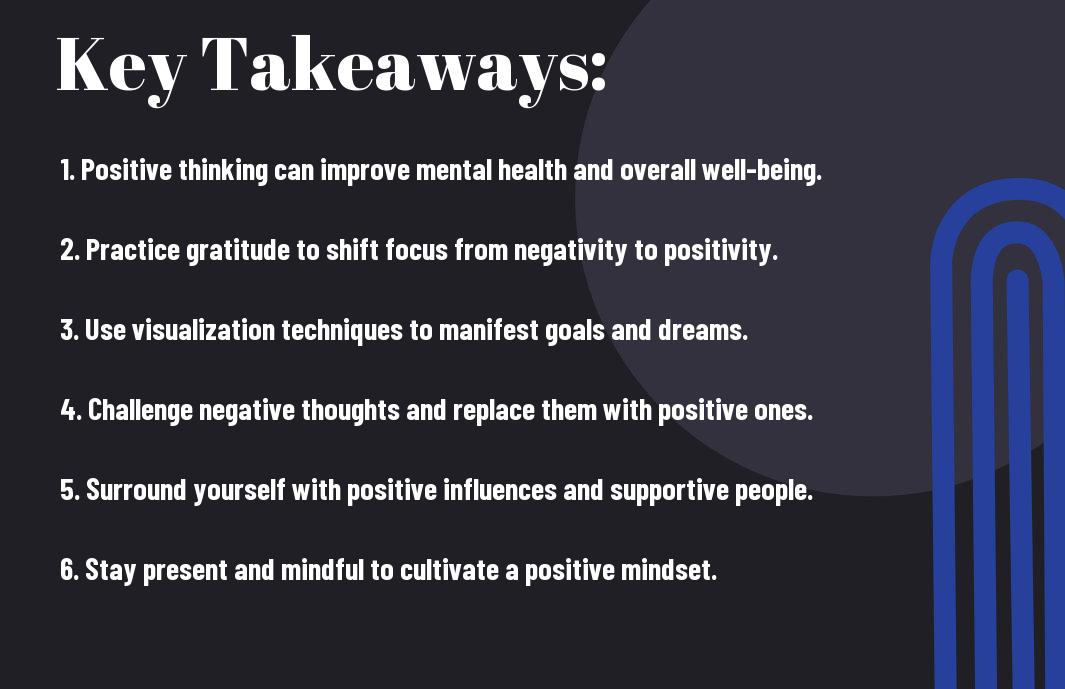Overcoming negative thoughts and embracing a positive mindset is crucial for achieving success and happiness in life. Positive thinking not only impacts our mental health but also our physical well-being. In this blog post, we will explore practical strategies and techniques to help you cultivate a more optimistic outlook on life. By implementing these methods into your daily routine, you can transform your mindset and attract more positivity into your life. Let’s dive into the power of positive thinking and discover how it can lead to a more fulfilling and rewarding life.
Key Takeaways:
- Foster a positive mindset: Embrace positivity by focusing on what is good in your life rather than dwelling on the negative.
- Practice gratitude: Take time each day to acknowledge and appreciate the things you are thankful for.
- Avoid negative thinking patterns: Challenge and replace negative thoughts with positive affirmations to rewire your brain towards optimism.
- Surround yourself with positivity: Spend time with people who uplift and support you, and engage in activities that bring you joy and fulfillment.
- Visualize success: Create a mental image of your goals and aspirations, and believe in your ability to achieve them through the power of positive thinking.

Understanding Positive Thinking
While positive thinking is often regarded as a vague concept, it is actually a powerful tool that can transform your mindset and ultimately your life. By consciously choosing to focus on the positive aspects of a situation, you can improve your mental and emotional well-being, increase resilience, and attract more positivity into your life.
The Psychology Behind Positive Thinking
With a foundation in cognitive psychology, positive thinking revolves around the idea that our thoughts influence our feelings and behaviors. When we train our minds to adopt a positive outlook, we are rewiring our brains to seek out solutions, opportunities, and silver linings in any given situation. By practicing positivity regularly, we can create a more optimistic and resilient mindset that can help us navigate life’s challenges with grace and determination.
Myths about Positive Thinking
With the rise of positive thinking approaches in popular culture, there are several myths that need to be debunked. One common misconception is that positive thinking means ignoring or denying reality. In fact, positive thinking does not require you to ignore problems or challenges; it simply encourages you to approach them with a constructive and hopeful mindset.
Debunking Myths About Positive Thinking
To truly harness the power of positive thinking, it is important to understand that it is not about wishful thinking or living in a state of denial. Positive thinking is about adopting a proactive and solution-focused mindset that helps you see obstacles as opportunities for growth and learning. By reframing setbacks as temporary and surmountable challenges, you can approach them with confidence and determination.
Cultivating a Positive Mindset
Your mindset plays a significant role in shaping your reality. Positive thinking can lead to improved mental health, increased resilience, and better overall well-being. Cultivating a positive mindset is a practice that requires conscious effort and dedication.
Everyday Habits for Positive Thinking
The way you start your day can set the tone for the rest of it. Incorporating positive affirmations and gratitude into your morning routine can help shift your focus towards the good things in your life. Additionally, practicing mindfulness and deep breathing exercises throughout the day can help you stay grounded and focused on the present moment.
Engaging in activities that bring you joy and fulfillment, such as exercise, hobbies, or spending time with loved ones, can also contribute to a positive mindset. Surrounding yourself with positive influences and avoiding negative environments or people can further support your journey towards cultivating a positive mindset.
Strategies to Overcome Negative Thoughts
With intentional self-reflection and awareness, you can begin to identify recurring negative thought patterns. Once you recognize these thoughts, challenge them by replacing them with positive affirmations or reframing the situation in a more positive light. Journaling can be a helpful tool in this process, allowing you to track your thoughts and emotions.
Positive visualization techniques, such as creating a vision board or practicing guided imagery, can also help in overcoming negative thoughts. By visualizing a positive outcome or goal, you can reprogram your mind to focus on the possibilities rather than the limitations. Keep in mind, consistency and patience are key in changing your thought patterns and cultivating a positive mindset.
Advanced Techniques for Positive Thinking
Now, let’s examine into some advanced techniques to further enhance your positive thinking abilities. These strategies will help you cultivate a more positive and resilient mindset, enabling you to overcome challenges and achieve your goals with confidence.
| Visualization and Positive Thinking | Mindfulness and Meditation Practices |
| To effectively harness the power of positive thinking, visualization techniques can be incredibly potent. By vividly imagining your desired outcomes and goals, you can create a mental image of success that motivates and inspires you. Visualizing positive scenarios also helps rewire your brain to focus on opportunities and solutions rather than obstacles. | To foster a more mindful and positive mindset, incorporating meditation practices into your daily routine can be highly beneficial. Mindfulness techniques such as deep breathing exercises, body scans, and mindful awareness of thoughts and feelings can help you stay grounded, present, and focused on the positive aspects of your life. |
Visualization and Positive Thinking
To further enhance the effectiveness of visualization, try to engage all your senses in the mental imagery. Imagine not just how achieving your goals looks, but also how it feels, sounds, smells, and even tastes. This multisensory approach can make your visualizations more vivid and compelling, reinforcing your positive beliefs and intentions.
Mindfulness and Meditation Practices
To deepen your mindfulness practice, consider incorporating meditation into your daily routine. Set aside a few minutes each day to sit quietly, focus on your breath, and observe your thoughts without judgment. By cultivating this awareness and acceptance, you can gradually train your mind to stay positive and resilient in the face of challenges.
Practices: Regular meditation and mindfulness practices have been scientifically proven to reduce stress, enhance emotional well-being, and improve overall mental clarity. By making these practices a consistent part of your routine, you can unlock the transformative power of positive thinking and cultivate a more joyful and fulfilling life.
Positive Thinking in Practice
Despite the challenges that come with adopting positive thinking as a way of life, the benefits far outweigh the obstacles. Developing a positive mindset is not only crucial for personal happiness and success but also for fostering healthy relationships and increasing productivity. Let’s investigate into how you can apply positive thinking to various aspects of your life.
Applying Positive Thinking in the Workplace
Practice positive thinking in the workplace by reframing challenges as opportunities for growth. Instead of fixating on problems, focus on finding solutions. Encourage a positive work environment by expressing gratitude, providing support to colleagues, and maintaining a can-do attitude. When faced with setbacks, view them as temporary roadblocks rather than insurmountable hurdles. By adopting a positive mindset at work, you not only boost your own morale but also inspire those around you.
Building Positive Relationships Through Optimism
Workplace relationships can significantly benefit from building positive connections through optimism. Practice active listening, offer praise and encouragement, and approach conflicts with a solution-oriented mindset. Optimism in relationships can lead to improved communication, trust, and collaboration. By fostering a positive outlook in your interactions, you can cultivate sustainable and fulfilling relationships both personally and professionally.
Positive relationships are instrumental in creating a supportive and harmonious work environment. They contribute to increased job satisfaction, decreased stress levels, and enhanced overall well-being. When individuals approach interactions with optimism and positivity, they pave the way for successful collaborations and long-lasting connections.
Final Words
With this in mind, unlocking the power of positive thinking through practical strategies and techniques is key to achieving success and happiness in life. By shifting your mindset and focusing on positive thoughts, you can overcome challenges, increase your self-confidence, and attract more opportunities into your life. Remember to practice techniques such as gratitude, affirmations, and visualization regularly to harness the full potential of positive thinking. With dedication and commitment, you can truly transform your life for the better. So, start incorporating these strategies into your daily routine and witness the powerful impact of positive thinking on your overall well-being.
FAQ
Q: What is positive thinking?
A: Positive thinking is a mental attitude that focuses on the bright side of life and expects favorable results. It involves optimism, hope, and a belief in one’s ability to overcome challenges.
Q: Why is positive thinking important?
A: Positive thinking can lead to numerous benefits such as increased resilience, better mental health, improved physical well-being, stronger relationships, and enhanced problem-solving skills.
Q: How can I unlock the power of positive thinking?
A: You can unlock the power of positive thinking by practicing gratitude, cultivating optimism, reframing negative thoughts, visualizing success, surrounding yourself with positive influences, and setting realistic goals.
Q: What are practical strategies for maintaining a positive mindset?
A: Practical strategies for maintaining a positive mindset include practicing mindfulness, engaging in regular physical exercise, connecting with supportive people, challenging negative self-talk, and celebrating small victories.
Q: What techniques can I use to shift from negative to positive thinking?
A: Techniques for shifting from negative to positive thinking include practicing affirmations, focusing on solutions rather than problems, engaging in acts of kindness, learning from setbacks, and staying present in the moment.







